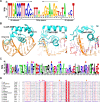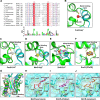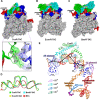Bacterial MerR family transcription regulators: activationby distortion
- PMID: 35130613
- PMCID: PMC9909328
- DOI: 10.3724/abbs.2021003
Bacterial MerR family transcription regulators: activationby distortion
Abstract
Transcription factors (TFs) modulate gene expression by regulating the accessibility of promoter DNA to RNA polymerases (RNAPs) in bacteria. The MerR family TFs are a large class of bacterial proteins unique in their physiological functions and molecular action: they function as transcription repressors under normal circumstances, but rapidly transform to transcription activators under various cellular triggers, including oxidative stress, imbalance of cellular metal ions, and antibiotic challenge. The promoters regulated by MerR TFs typically contain an abnormal long spacer between the -35 and -10 elements, where MerR TFs bind and regulate transcription activity through unique mechanisms. In this review, we summarize the function, ligand reception, DNA recognition, and molecular mechanism of transcription regulation of MerR-family TFs.
Keywords: MerR; RNA polymerase; gene expression; gene transcription; transcription factor.
Conflict of interest statement
The authors declare that they have no conflict of interest.
Figures






Similar articles
-
CueR activates transcription through a DNA distortion mechanism.Nat Chem Biol. 2021 Jan;17(1):57-64. doi: 10.1038/s41589-020-00653-x. Epub 2020 Sep 28. Nat Chem Biol. 2021. PMID: 32989300 Free PMC article.
-
Structural visualization of transcription activated by a multidrug-sensing MerR family regulator.Nat Commun. 2021 May 11;12(1):2702. doi: 10.1038/s41467-021-22990-8. Nat Commun. 2021. PMID: 33976201 Free PMC article.
-
Mutations in the alpha and sigma-70 subunits of RNA polymerase affect expression of the mer operon.J Bacteriol. 1997 Mar;179(5):1787-95. doi: 10.1128/jb.179.5.1787-1795.1997. J Bacteriol. 1997. PMID: 9045842 Free PMC article.
-
The MerR family of transcriptional regulators.FEMS Microbiol Rev. 2003 Jun;27(2-3):145-63. doi: 10.1016/S0168-6445(03)00051-2. FEMS Microbiol Rev. 2003. PMID: 12829265 Review.
-
Global regulators of transcription in Escherichia coli: mechanisms of action and methods for study.Adv Appl Microbiol. 2008;65:93-113. doi: 10.1016/S0065-2164(08)00604-7. Adv Appl Microbiol. 2008. PMID: 19026863 Review. No abstract available.
Cited by
-
The Copper Efflux Regulator (CueR).Subcell Biochem. 2024;104:17-31. doi: 10.1007/978-3-031-58843-3_2. Subcell Biochem. 2024. PMID: 38963481 Review.
-
Whole-Cell Biosensor for Iron Monitoring as a Potential Tool for Safeguarding Biodiversity in Polar Marine Environments.Mar Drugs. 2024 Jun 28;22(7):299. doi: 10.3390/md22070299. Mar Drugs. 2024. PMID: 39057408 Free PMC article. Review.
-
Determinants of mer Promoter Activity from Pseudomonas aeruginosa.Genes (Basel). 2024 Apr 13;15(4):490. doi: 10.3390/genes15040490. Genes (Basel). 2024. PMID: 38674424 Free PMC article.
-
Transcription activation by the resistance protein AlbA as a tool to evaluate derivatives of the antibiotic albicidin.Chem Sci. 2023 Apr 17;14(19):5069-5078. doi: 10.1039/d3sc00955f. eCollection 2023 May 17. Chem Sci. 2023. PMID: 37206387 Free PMC article.
-
Identification of a preferred DNA binding sequence and novel regulon member for CadR in Pseudomonas aeruginosa PAO1.Front Microbiol. 2025 Jul 14;16:1608957. doi: 10.3389/fmicb.2025.1608957. eCollection 2025. Front Microbiol. 2025. PMID: 40727560 Free PMC article.
References
-
- Chamberlin M, Berg P. Deoxyribo ucleic acid-directed synthesis of ribonucleic acid by an enzyme from Escherichia coli . Proc Natl Acad Sci U S A. . 1962;48:81–94. doi: 10.1073/pnas.48.1.81. - DOI - PMC - PubMed
-
- Feklistov A, Sharon BD, Darst SA, Gross CA. Bacterial sigma factors: a historical, structural, and genomic perspective. Annu Rev Microbiol. . 2014;68:357–376. doi: 10.1146/annurev-micro-092412-155737. - DOI - PubMed
-
- Seshasayee AS, Sivaraman K, Luscombe NM. An overview of prokaryotic transcription factors: a summary of function and occurrence in bacterial genomes. Subcell Biochem. 2011,52: 7-23 - PubMed
-
- Browning DF, Busby SJW. Local and global regulation of transcription initiation in bacteria. Nat Rev Microbiol. . 2016;14:638–650. doi: 10.1038/nrmicro.2016.103. - DOI - PubMed
Publication types
MeSH terms
Substances
LinkOut - more resources
Full Text Sources

